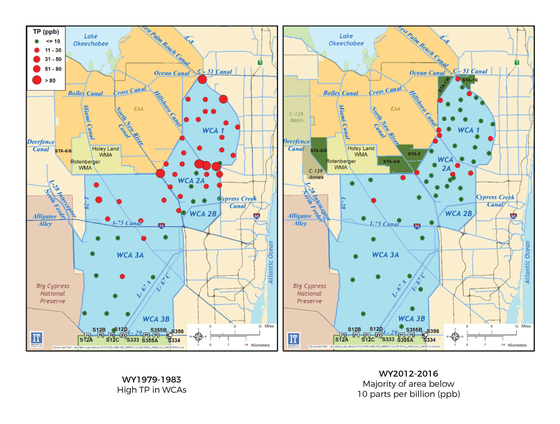South Florida Ecosystem Restoration Task Force
Celebrates 20th Anniversary
The South Florida Ecosystem Restoration Task Force recently celebrated its 20th anniversary, commemorating both historic Everglades restoration accomplishments and continued progress. The Everglades Task Force is composed of 14 federal, tribal, state and local government representatives, who coordinate the numerous projects that benefit the ecosystem and provide for regional water needs.
Drew Bartlett, DEP deputy secretary for Ecosystem Restoration and South Florida Ecosystem Restoration Task Force Vice Chair, presented an Everglades water-quality update and reflected upon the improvements made as a result of successful partnerships. One of the highlights of his update included nutrient reduction in water conservation areas, as depicted in the maps below. On the left, elevated phosphorus levels were detected from 1979-1983 as represented by the red dots. On the right, in recent years, phosphorus levels have seen a significant decline as represented by the green dots, thanks in part to phosphorus reduction mandates, construction of and refined operation of the stormwater treatment areas, and implementation of agricultural best management practices. Nutrient reduction is a key component to providing a
clean water supply, wildlife habitats and recreational activities in South
Florida.

DEP Dedicated to Protecting Florida Everglades
Click on image for full-screen version.
The Florida
Department of Environmental Protection plays a key role in the largest
environmental restoration project in the world – restoring America’s Everglades. The Everglades ecosystem covers 18,000 square miles, stretching from Orlando through the Florida Keys. A healthy ecosystem is vital to a healthy economy, and Florida is committed to protecting the Everglades.
Since 2011, 15 restoration projects have been completed in conjunction with department efforts, with 19 projects currently under construction. Planning for future restoration projects is underway as well, ensuring continued protection and restoration of one of our most vital environmental resources.
To ensure a recurring dedicated funding source for continued restoration progress, in 2016, Governor Scott signed Legacy Florida legislation that dedicates a significant amount of funding – around $200 million annually – for Everglades restoration.
Restoration
goals include:
- Improved
water quality, water supply and wildlife habitat while maintaining flood
protection;
- Reduced
excess freshwater releases to coastal estuaries; and
- Improved
water delivery to Biscayne and Florida bays.
DEP’s Office
of Ecosystem Projects ensures that agency policies and responsibilities focus
on a holistic approach to South Florida ecosystem restoration. DEP staff
members participate in project creation and planning to ensure they
meet regulatory requirements and restoration goals. Plan elements are complex
and require a balanced approach to the protection of ecological resources with
the often competing objectives of water supply and flood control.
For additional information on DEP's Everglades restoration projects and programs, click here.
|